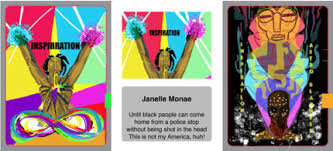How do we make slower, more restorative, community-driven futures seem irresistible? Future Shock gives lessons from 50 years ago
Fascinating piece from The Atlantic’s Samantha Culp, asking what kind of “pop futurism” we now need to prepare ourselves for the next few decades. At A/UK we are really interested in thinking and stories about the future. They open up inclusive spaces which communities can occupy for a moment, in order to find their common willpower and intent.
So we want the future to be pop - or at least come to people as if they think they have an active role in it, rather than just being the passive victims of it. But what’s the best tone or attitude to take?
The Atlantic piece goes back to the beginning of pop futurism, 50 years ago, with the publication of Alvin Toffler’s Future Shock - hugely successful, and thus perhaps providing clues as to how to evoke a future that compels a mass audience.
The times were certainly different:
Future Shock’s central argument may be recognizable, perhaps because Toffler argued it so convincingly that it became a cliché: The world was changing at an exponentially accelerating pace, leaving humans in a state of “shock” and struggling to keep up.
At least in the countries of the developing West, society experienced a profound historical shift as the industrial revolution gave way to information economies; that shift was in turn sped up by new technologies of mass communication.
Confronted by a tsunami of change, most people were anxious, disoriented, and confused. The book sought to diagnose this novel condition, to show its “sources and symptoms,” and to ponder possible ways to mitigate its effects.
The chief strategy for combatting future shock, according to Toffler, was to double down on the future itself. He called for government committees to fund large-scale future studies, for science-fiction writers to bring more methodical forecasting to their stories, for American schools to teach future-oriented courses (as a counterpoint to history classes).
“To create such images and thereby soften the impact of future shock,” he wrote, “we must begin by making speculation about the future respectable.”
This was not a new challenge; even H. G. Wells had taken pains to emphasize that the systematic attempt to project potential futures based on contemporary data could be a science, not mere fortune-telling.
But Toffler’s book pushed futurism into the mainstream, not just in the realm of militarism (i.e., the type of nuclear-scenario planning pioneered at the RAND Corporation) but also in the “soft” spaces of everyday life, from “politics and playgrounds to skydiving and sex.”
She’s right, this is familiar - Yuval Noah Harari has literally revived the formula across recent books. But Culp also notes how other current “futuring” books are much less gung-ho and tentative than Toffler. Roman Kraznaric’s The Good Ancestor (mentioned on this blog) urges readers to act as if they are responsible to future generations now. And rather than the tidal wave (Toffler’s dominant metaphor), Roman’s image for the future is the acorn, planted now, building up a mighty structure later.
Another futures operator, Scott Smith (again featured here), in his recent “How To Future” book, which “attempts to open up the ‘futuring toolkit’ for diverse audiences and goals, illustrating the application of methodologies such as scenario planning, which has its roots in Cold War militarism, in fields such as nonprofit management and public health.”
Culp also mentions Afro-Rithms From The Future, a card game - see images below
The game draws on Afrofuturist thought and art to encourage radical visions of a more just world, and group discussion to model the types of present-day changes that could lead us there.
The cosmic, jewel-toned cards are inviting, a vivid contrast to the blue-laser graphics that too often are a default “future” aesthetic, but like any good talisman, they need a specific process to unlock their potential—the collaborative gameplay itself.
Unlike a linear book, interactive card decks and collective storytelling projects may best embody the strange, mutable, participatory ways the actual future unfolds.



Even before the coronavirus pandemic surged across the world in early 2020, the catastrophic threats facing the planet—climate change, rising nationalism, systemic inequality, technology that is creating more problems than it solves—had shattered any sense of a stable tomorrow.
Our default image of the future has become far more Children of Men than The Jetsons, and even our stock cyberpunk dystopias have started to seem quaint. But as the faintest of silver linings, perhaps this is the year when we’ll be able to see most clearly that we need an entirely new way of talking about the future if we are to shape it into something equitable and sustainable for all.
Now, just as in 1970, the future is made by intricate interactions of people, systems, communities, material and environmental conditions—and by the stories that influence those relationships. This new chapter of pop futurism shows its enduring appeal as a familiar dialect, even if the message it carries is now an urgently different one. It might still have the potential to illustrate new visions of the future for a healthier world, but it needs to feel as vivid and magnetic as Future Shock did 50 years ago.
As Toffler and his acolytes once made the accelerated, profit-driven future dazzling, the next generation of thinkers is trying to reconcile this paradox—to conjure slower, more restorative, community-driven futures that are just as irresistible.


